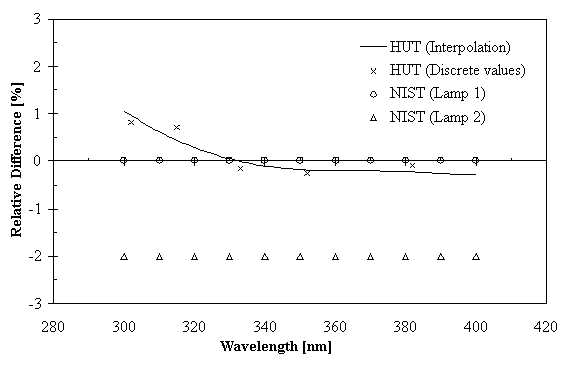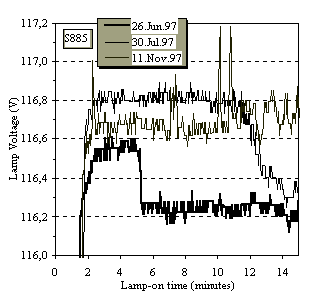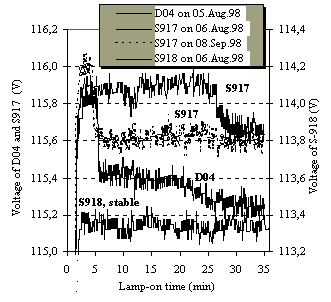
The official newsletter of the Thematic
Network for Ultraviolet Measurements
Issue 2 / March 1999


Contents
The Second Workshop in Braunschweig, November 9 - 11, 1998
Announcing the Third Workshop in Teddington, September 8 - 10, 1999
Training Course for Ultraviolet Measurements, September 6 - 8, 1999
Annual Reports of the Working Groups
2nd International Workshop on Detector-Based UV Radiometry, Madrid, Spain, 28 October 1999
ISSN 1456-2537
Picaset OY, Helsinki 1999
UVNEWS is the official newsletter of the Thematic Network for Ultraviolet Measurements. The Network is funded by the Standards, Measurements and Testing programme of the Commission of the European Communities, as project number SMT4-PL96-9329. UVNEWS is published twice a year. It is aimed to exchange knowledge between the participants of the Network and to disseminate information on the forthcoming and past activities of the Network. The newsletter also contains scientific and technical articles on UV measurements and a news-section about activities in the field of UV measurements. The newsletter welcomes all announcements and articles which might be of importance for the readers. Material to be published in UVNEWS should be sent to:
Helsinki University of Technology
Metrology Research Institute
Petri Kärhä
P.O.Box 3000
FIN-02015 HUT, Finland
Telefax: +358 - 9 - 451 2222
E-mail: petri.karha@hut.fi
In case of longer articles or announcements, use of E-mail is preferred. The third issue of UVNEWS is scheduled for July 1999. Material to be published should be sent by June 11.
Co-ordinators Column
Thematic Network contributes to improve measurements
at UV
In a recent questionnaire national measurement institutes were asked to identify the needs of their customers and specify priority research areas. The inquiry was directed to the member laboratories of the Consultative Committee for Photometry and Radiometry. More than 80 % of the replies indicated the importance of continued work at ultraviolet wavelengths. The need of improved UV measurements is caused by industrial and environmental applications. The significance of the subject is also recognised by the European Union which is funding, in addition to the Thematic Network, a large research project aiming at improving the accuracy UV radiation measurements.
The Thematic Network arranges a series of workshops with participants from research laboratories, universities and industry to discuss common problems and themes. The Network has also identified four key issues and established working groups to study these subjects in more detail. At the Braunschweig workshop in November 1998, these working groups organised themselves and set objectives for further work. The discussions will continue in the coming Teddington workshop where much of the time will be devoted to the working group activities.
It was recognised in the previous workshop that most of the preparative work of the working groups needs to be carried out between the meetings by correspondence. To help in sending out group E-mails and keeping updated mailing lists, we have established the Network WWW pages (http://metrology.hut.fi/uvnet/). These pages also contain reports, minutes and other documents of the previous workshops and working group meetings. Registration forms and links to future events are included on the WWW pages.
A printed version of the UVNEWS will be published for the benefit of those who prefer to receive on paper the material related to Network activities. The present issue of the UVNEWS contains the preliminary programme and registration forms of the Teddington workshop (see page 36). In July, the next issue will appear with more detailed information on the workshop and the associated training course.
It is the aim of the Network and its workshops, working groups, and training courses to help in meeting the need of improved measurements at UV wavelengths. The three-year Network contract is soon in the middle and we are approaching the time to evaluate the value of these activities. Such a milestone is set in the contract with the results of the evaluation to be reported to the Commission in the second annual report.
Erkki Ikonen
Co-ordinator of the Thematic Network
The Second Workshop in Braunschweig,
November 9 - 11, 1998
The Network arranged its second workshop in Braunschweig, Germany, on November 9-11, 1998. The second workshop was not restricted to the members of the Network, as the first workshop was. The number of participants therefore increased to 88. Many of the participants were from other than the participating organisations, which expands the Network significantly. It should be noted that some participants came from China, Czech Republic, Poland and United States, which indicates that the Network has also generated interest outside the European Union. There were also new participants from France.
A major part of the meeting time was allocated to parallel sessions of the Working Groups, and to presentations of the Working Group leaders on their progress. Progress reports of the Working Groups may be found starting from page 42.
Thirteen oral presentations were given in the workshop. The topics were selected so that each of the four working groups selected three presentations. Neil Harrison was invited to present the new EU project "Improving the accuracy of ultraviolet radiation measurement." In addition, 13 posters were presented. The complete list of titles, authors, and abstracts of the presentations may be found in the Internet-pages of the Network (http://metrology.hut.fi/uvnet/2wsextab.htm). The minutes of the workshop (http://metrology.hut.fi/uvnet/2wsmin.htm) may be found there as well.
All authors had the option to submit an extended abstract of their presentation. The following section contains a selection of these extended abstracts.
The key achievement of the 2nd workshop was clearly the meeting of the working groups. Getting to know each other personally has increased the activity within the working groups. Many participants expressed their feeling that even more time could be allocated for the working groups. This has now been taken into account in the programme for the 3rd workshop. Agreement on the contents and schedules for the training course and the next workshop can be listed as main achievements as well.
PK
(Photographs: Cover - Participants of 2nd workshop, Page 4 - The local organiser, Dr. Werner Möller (left), discussing in the evening party with Dr. Tapani Koskela of the Finnish Meteorological Institute. For more pictures from the workshop, see http://metrology.hut.fi/uvnet/2wsphoto.htm)
Extended Abstracts
Characterising the performance
of integral measuring UV-meters
Summary
Within the field of radiometry, the market offers a great number of instrumentation. In many cases it is impossible for the user to make the right choice, because currently no agreed definitions for a characterisation exist. This paper highlights some definitions on characterisation, approved for photometers, which are transferred for UV and other actinic radiation measuring equipment.
Introduction
The quality of radiometers is determined by different parameters, which have again individual influence for a specific measuring task. An ideal situation would be to describe the quality by just one number, which additionally indicates the measuring uncertainty to be expected. Because of the multi-dimensional parameters, some times influencing each other, this is not possible in general.
The parameters for which a numerical assessment is possible are:
- spectral responsivity,
- response beyond the limits of the considered weighting function,
- directional response,
- characteristics of the display unit,
- fatigue,
- influence of temperature,
- influence on modulated radiation,
- effect of polarised radiation,
- influence of in-homogenous irradiation on the acceptance area, and
- influence of a range change.
Presentation of the Relative Spectral Responsivity
There are several possibilities for presenting the normalised spectral responsivity s()rel of a detector. It is i.e. possible to refer the measured response data to its maximum response at 0
s()rel,1 = s()/ s(0), (1)
or it can be referred to a mean value response.
s()rel,2 = s()/ sm, (2)
with

Both quantities are related to each other by
s()rel,1 = k s()rel,2. (4)
Plotting the normalised spectral responsivity of one detector using equations (1) and (2) will provide different curves, but in respect to the matching for a prescribed weighting function, they are the same. Therefore, a direct comparison with a prescribed weighting function is not possible. This is because the quality for the matching does not depend on the absolute responsivity values, only on the relative shape.
On calibrating (adjusting) the radiometer head, when a defined light source S,c is used, the following will be set:

A much more suitable normalisation is therefore achieved [1], if
s*()rel = cs()rel,1 = cks()rel,2, (6)
leading to the definition

where S,c - spectral distribution of the illuminant used for calibration, s()eff,rel - relative spectral weighting function, s()rel - relative spectral responsivity, and s*()rel - normalised relative spectral responsivity considering the calibration source.
The Quality of Spectral Matching
For describing the quality of a spectral matching for a detector towards a desired weighting function, it seems that two definitions are under consideration. One known as f1' uses the spectral responsivity, which is normalised considering the distribution of the calibration source, as mentioned above. It calculates the area shaped by the deviation of this normalised spectral responsivity and the considered weighting function.

where s()eff,rel - relative spectral weighting function, s()rel - relative spectral responsivity, and s *()rel - normalised relative spectral responsivity considering the calibration source.
This f1' characterisation can not be used as a correction factor in practical measurements. It is only useful for comparing radiometer heads. It only has advantages in respect to optimise a spectral matching, but for the general user this definition seems to be misleading.
The other definition f1(Z) simply describes the deviation for an actual source in respect of that source used for calibration as

where
sZ - radiometric responsivity of the radiometer head using source Z, sC - radiometric responsivity of the radiometer head using the calibration source c, and a(Z) - spectral mismatch correction factor for the used source Z, which is defined as

This defines a normalised systematic error for a type of source considered. Therefore, this can be used as a correction factor in practical measurements. For a data sheet describing the spectral mismatch, a set of different applicable light sources shall be listed, for which the systematic errors f1(Z) are stated or at least the largest number f1(Z)max . The numerical value will be considerable much lower compared to values obtained with the f1' definition.
Outer Limit Response
An ideal radiometer head for a considered weighting function has no response for radiation beyond the respective spectral bounds. For testing, a suitable source emitting a high level of radiation, in either the short or long wavelength range, can be found for a respective weighting function. The detector has to be exposed to that radiation with and without a filter. The filter characteristics should preferably exclude the active range of the considered weighting function and must be defined. The respective formulas can easily be derived from those introduced for photometers [3, 4]. For this characterisation, one has to keep in mind that such definitions serve only for comparing the quality of two radiometer heads and do not serve for estimating any uncertainties.
In theory, one can avoid the test, if the apparatus used for determining the spectral responsivity allows to perform measurements in a sufficient broad and sensitive range. Then, this influence is already taken into account in equation (9).
Directional Response
The effect of radiation depends on the angle of incidence for the considered surface. For a radiometer head, the directional response is fixed by its optical construction. Since the main application for integral measuring UV radiometers is for practical reasons in the field, where radiation generally enters the surface of interest from all directions. The most interesting quantity here is the irradiance on a horizontal surface. The directional response has to follow the cosine of the angle of incidence. The procedure for characterisation can directly be copied from that proved for photometers [3, 4] without any changes.
However, the finally found characteristic f2 can not serve for evaluating the uncertainty of a measurement, but in comparison with other radiometer heads, the definition is useful. At least it can be stated, that the uncertainty for general measurements will be lower than the value for f2 .
Other quantities with different directional response do exist, but are so far not applied in the field of UV- and other measurements of actinic radiation. A discussion about characterising is therefore not important and can be derived from other standards [3].
Spatial Responsivity
The construction of a radiometer head can have a significant influence on the spatial spectral and absolute responsivity over the acceptance area. This is without influence, when the aperture is uniformly irradiated. One way for characterising is to measure the local response at defined positions on the acceptance area, using a diaphragm as is used for photometers [3], where a characteristic f9 can be evaluated. This can directly be used for UV-meters as well.
It might be interesting to know that the spatial response characteristic is often larger for radiometer heads using diffusers than those for only perpendicular incidence using a diaphragm in the acceptance area.
References
[1] J. Krochmann and K. Reissmann, "Über den Spektralangleich von Strahlungsempfängern und von Lichtquellen," Optik 56, 83-94 (1980).
[2] J. Krochmann and E. Krochmann, "On the Measurement of Photobiological Effective Radiation," Proc.11. Int. Symp. Photon Detectors (IMECO Secretariat H1371, POB 457, Budapest, 1984) pp. 272-298.
[3] DIN 5032-6 , in revision, final Draft 1999.
[4] CIE Publ. No. 69 (1987).
Evaluation of the radiometric
performance
of UV photodetectors
of UV photodetectors
Significant improvement of detector-based UV radiometry is dependent on the accuracy achieved in the realisation of e.g. the spectral responsivity scale, as well as on the availability of appropriate transfer detector standards for the dissemination of the scales.
As for the realisation of the UV spectral responsivity scale, substantial progress was made in the past few years by using cryogenic radiometers as primary detector standards, operated with tuneable UV lasers or spectrally dispersed radiation from incandescent lamps or synchrotron radiation (SR) sources, respectively. A further step to reduce the uncertainty of the primary scale to about 0,5% (k=2) was undertaken recently at PTB by supporting the SR-based realisation with the laser-based technique. In addition, a new facility based on a Fourier transform spectrometer was established that allows to transfer the spectral responsivity scale to photodiodes, without significant loss in accuracy, and within a typical measurement time of about 5 minutes.
Despite this considerable progress in the realisation of the primary scale, the accuracy of the scale that is available at the user laboratory is still limited by the performance of the transfer detectors. In order to combine the search for better UV detectors, the agreed EUROMET project "Evaluation of the radiometric performance of UV photodetectors" was established in 1997 as a result of the first "International workshop on detector-based UV radiometry." A major goal of this joint activity of NIST, NPL, NMi-VSL, and PTB is to identify candidates for the construction of transfer detector standards to be employed e.g. in the future CCPR key comparison of UV spectral responsivity.
At the start of the project, a novel Schottky-type silicon photodiode had been developed at the ETH Zurich in cooperation with PTB. Prototypes of this new diode, the front contact of which consists of a 4-nm thin PtSi film, showed an unprecedented stability of the spectral responsivity under prolonged UV exposure [1]. A larger number of 10 mm 10 mm active area PtSi-n-Si photodiodes have been produced on the order of PTB as the pilot laboratory. Each partner was provided with three pristine samples and two specimens calibrated by PTB in the 200 nm to 400 nm spectral range. After the investigations by the partner institutes, that are still in progress, the photodiodes shall be returned to PTB for recharacterisation. The second international workshop on detector-based UV radiometry, that is planned to be a satellite meeting of the 1999 NEWRAD conference, will provide the stage for the discussion of the results of the combined activities. Just before the second workshop of the UV Thematic Network, the NPL finished the calibration of one of the photodiodes provided by PTB. The results of the two calibrations show a satisfactory agreement within the combined uncertainties, which is an important improvement as compared to the outcome of the international comparison of spectral responsivity some years ago [2].
References
[1] K. Solt et al., Appl. Phys. Lett. 69, 3662-3664 (1996).
[2] R. Köhler et al., Metrologia 32, 463-468 (1995/96).
On the measurement of actinic radiation -
methods and equipment
methods and equipment
The photobiologically-photochemically effective function (action spectra weighted function or actinic function), for the radiation effects on human eye and skin, could be described as follows. For the analysis of eye retina, actinic radiance [W/ (m² sr)]

where Le() is the spectral radiance of the radiation source, should be used.
For the analysis of human skin or damage of materials, actinic irradiance [W / m²]

where Ee() is the spectral irradiance of the radiation source, should be used.
Proposals for actinic spectra functions in UV, and in the extended longer wavelength range are presented in Figure 1.
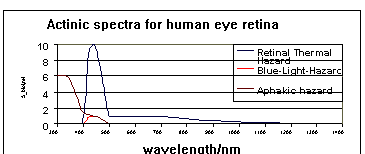
Figure 1. Actinic spectra for human eye retina.
As measuring methods and equipment for the quantitative determination of actinic irradiance and radiance, the spectral and integral methods are common. In case of the basis for the integral method, the spectral method has to be specified to get the best uncertainties while calibrating an integral system.
To get an idea of possible uncertainties with the spectral measurement method, two effects are shown in Tables 1 and 2. Measurements of two lamps, a sun tanning lamp - Arimed B - and a short arc lamp - HMI, are made with a Bentham double-monochromator DM150. From the results it can be seen that a wavelength shift of only 1 nm could cause an effect of about 20 % in the measurement results. Correspondingly, an increase of the bandwidth from 1 nm up to 10 nm, without a wavelength shift, could cause an effect of about 5%.
Table 1. Relative change of the erythema-effective irradiance in dependence upon the bandwidth.
With the spectral data E(), the erythema-effective irradiance can be calculated as
Eeryth = E()*Seryth () , = 200nm…400nm. (3)
Based on the knowledge of these figures, the first step is to
describe the spectral method before specifying any uncertainties
of the integral method.
Table 2. Relative
change of the erythema-effective irradiance in dependence upon
the wavelength shift.
Absolute calibration of erythemally
weighted broadband radiometers
weighted broadband radiometers
The absolute calibration of erythemally weighting (EW-) broadband meters is carried out in three steps.
Determination of relative spectral sensitivity
The relative spectral sensitivity of EW-meters is determined in the laboratory, using a double monochromator or a single monochromator with additional cut-off filters as the monochromatic source for the wavelength range 280 nm to 400 nm. A dynamic range of more than five orders of magnitude is necessary to characterise EW-meters with sufficient sensitivity in the UVB- and UVA-ranges.
Determination of absolute sensitivity
The absolute sensitivity of EW-meters gives the correlation between the detector output signal and the absolute detector weighted irradiance, expressed in W m2. To determine this calibration factor, synchronous measurements of solar irradiance with the EW-meter and a calibrated spectroradiometer are necessary. The measured spectrum (corrected for any possible cosine error of the spectroradiometer) is weighted with the relative spectral sensitivity of the EW-meter and integrated over the wavelength range 280 nm to 400 nm. The relation of this integral to the detector output should be constant over the day and under all atmospheric conditions. The only reason for a small systematic variation is the cosine error of the EW-meter. In routine operation, it is very difficult to correct for the cosine error of the EW-meter. Therefore, it is better to include an average correction already in the calibration factor.
Determination of the absolute erythemally weighted irradiance
The relation between the absolute detector weighted irradiance and the erythemally weighted irradiance is dependent on the spectrum of the sun, in particular on solar zenith angle and total ozone column. This conversion is carried out best using lookup tables, generated from a radiative transfer model, which calculates the ratio between the two weighting functions (detector sensitivity and standardised erythema action spectrum) in dependence on the various parameters. By this way, the radiative transfer model is not used to determine the absolute erythemally weighted irradiance, but only to calculate a relative correction factor, which is not very sensitive to the choice of model input parameters like aerosol content, altitude above sea level, vertical ozone profile or cloudiness.
In practice, each individual reading of an EW-meter has to be converted first to absolute, detector weighted units by applying the calibration factor and then - based on actual solar elevation and ozone content - the absolute, erythemally weighted irradiance is calculated in W m2 or as the UV-index using the look-up tables. The quality of the whole calibration procedure can be tested by simultaneous spectral measurements, from which the erythemally weighted irradiance can be calculated by integration over the erythemally weighted spectral irradiance. An overall accuracy of the calibration of EW-meters on the order of ± 3 % can be achieved with this procedure. This accuracy is of course only valid relative to the calibration of the spectroradiometer used. Furthermore, practical experience in the Austrian UVB-monitoring network has shown that the calibration of EW-meters may change significantly during the time of usage, which makes additional quality control procedures essential.
Uncertainty estimate for the
spectral
measurement of solar UV radiation
measurement of solar UV radiation
The World Meteorological Organisation has recently published Guidelines for Site Quality Control of UV Monitoring [1] detailing methods of evaluating the uncertainty associated with the spectral measurements of solar UV radiation. Following the algorithms and figures provided in the Guidelines will lead to a typical uncertainty in the measurement of solar UV radiation using an instrument with known characteristics.
The overall uncertainty is a combination of uncertainties due to calibration source and methods, instrument characteristics, solar spectrum and mode of measurement. Where the solar spectrum and/or radiance distribution are required for calculation of a source of uncertainty, a representative spectrum/radiance distribution is used to provide users with a simple algorithm for calculating the associated representative uncertainty for their instruments. The final combined uncertainty is thus achieved by a transparent method and comparable amongst different instruments. However, the uncertainty may not be directly applicable to a particular measurement at a given time and place. Details of the instrument characteristics are required for several of the individual uncertainty estimates. Ideally, characteristics should be determined for a specific instrument, and brief details of the methods for such determination are given. However, characteristics typical of a model of instrument may be used if specific instrument details are not available. Algorithms and forms for assessing uncertainties for both spectral and broadband (erythemally weighted) radiometers are provided with the Guidelines.
A copy of the Guidelines should have reached many members of the Thematic Network for Ultraviolet Measurements via a recent WMO mailshot. If you have not received a copy, please contact Liisa Jalkanen at WMO or Ann Webb (who now has a limited stock of reports).
References
[1] A. R. Webb, B. G. Gardiner, T. J. Martin, K. Leszczynski, J. Metzdorf, and V. A. Mohnen, Guidelines for Site Quality Control of UV Monitoring, WMO/GAW No. 126 (WMO, Geneva) 39 p.
Calibration of broadband UV radiometers at NPL
There is a widespread customer requirement for cheap calibration of UV detectors at accuracies of the order of 10 %, for applications such as non-destructive testing and medicine. A facility has been set up at the NPL to meet this requirement.
The main techniques used at NPL for detector responsivity measurement are:
- laser-based methods, in which the response of detectors to monochromatic radiation from fixed wavelength or wavelength-tuneable lasers is measured, and
- double monochromator methods, in which the output of broadband spectral sources is dispersed in the monochromator to give monochromatic radiation.
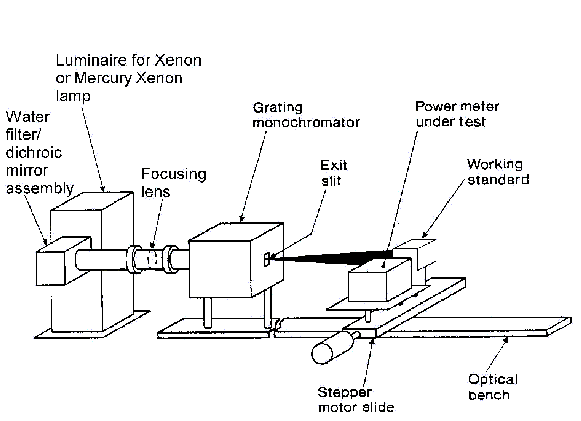
Figure 2. Schematic of the NPL Intense UV Facility.
While the laser-based methods permit measurement at the highest accuracy and the highest spectral power levels, they are time-consuming and expensive to perform. The double monochromator methods have the advantage of ease of use, but at the price of low output power (of the order of 50-100 W in the 350-400 nm region over a 10 nm bandwidth). A facility - the NPL Intense UV Facility - has therefore been developed using a single monochromator to give output powers an order of magnitude or more higher (see Figure 2).
The radiation sources used are 1 kW xenon and mercury-xenon sources. The former provides a continuum emission from 250 to 400 nm, whereas the latter provides a series of intense spectral lines at the mercury emission wavelengths in this region, suitable for measurement at high irradiance levels. Radiation from the source is imaged on to the entrance slit of the monochromator using refractive optics. The major disadvantage of using a single monochromator is stray light. This is reduced by using a combination of a UV selective dichroic mirror and a water filter prior to the monochromator. Radiation from the monochromator exit slit is then incident on the detectors to be measured, which are mounted on a translation stage allowing movement in and out of the beam. This radiation is divergent, giving a large uniform patch of radiation. Moreover, the irradiance level at the detectors can be readily adjusted by movement of the detector stage towards and away from the exit slit. Slit widths corresponding to spectral bandwidths of 5, 10 and 20 nm are used.
The mercury-xenon lamp provides the highest power levels at the mercury emission lines. In particular at 365 nm, a power level of 20 mW can be obtained. This gives rise to an irradiance of 5 mW cm2 for a patch with irradiance non-uniformity of less than 3 % over an area of 20 mm in diameter, allowing irradiance response calibration of detectors of this area. At 296 nm, a power level of 3 mW can be obtained, with a corresponding irradiance of 0,7 mW cm2 for a 20 mm diameter patch uniform to within 3 %. The stray light level varies with the wavelength used: at 365 nm it has been measured to be less than 1 %.
Traceability to National standards for spectral responsivity is achieved in the following way:
- An apertured silicon photodiode is calibrated for irradiance response using the NPL standard double monochromator facility for Spectral Responsivity calibration. This serves as the primary transfer standard for the single monochromator system.
- A "working standard" detector - either a thermopile or a second silicon photodiode - is calibrated for irradiance against this primary standard using the NPL Intense UV Facility, prior to the calibration of customer detectors.
- Calibration of customer detectors is then performed against the working standard.
The best calibration uncertainty at 365 nm that can be achieved is 4 % for a confidence level of 95 %, the dominant contributor being the spatial non-uniformity of the irradiance field.
Control measurements in old
/ used sunbeds
European and national normative regulations describe the UV radiation measurement conditions in sunbeds. These regulations are valid for the determination of type classifications of new produced sunbeds. Spectroradiometric measurements are done with just a few or just one prototype with a defined combination of lamps, filters, etc. There are no real regulations concerning the control of sunbeds which are used in thousands of solaria, despite the fact that the UV emission properties of these sunbeds are certainly different to the one determined with the prototype. This is due to ageing effects, altered lamps, filters and electrical components, and sometimes due to improper manipulations of the sunbed, or due to damages of some optical components.
To determine the correct irradiation time in a sunbed, it is of importance to avoid a sunburn due to its skin damaging capacity. Therefore, measurements of the erythemal effective radiation of the whole UV spectral region is recommended. In order to determine the radiation conditions which are relevant for the customer in a solarium, it is important to perform the measurement in a proper way.
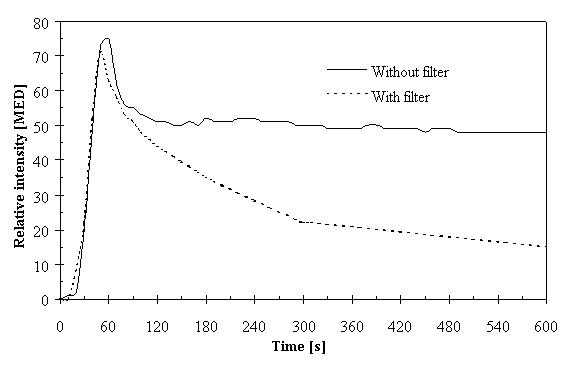
Figure 3. Relative MED-weighted intensities of a high-pressure sodium lamp used in a solarium device. The solid line gives the intensity of an unfiltered lamp, whereas the dotted line depicts the intensity of a lamp which has been modified with a filter, the transmittance of which depends on its temperature.
Filters of the sun-tanning devices may change the optical properties dramatically within the first minutes after starting a "sunbathe," as is demonstrated in Figure 3. Therefore, the correct timing of the measurement is of importance. One should always try to detect the highest intensity of the tanning device (worst case). So, the optimal time to perform a measurement may not be 30 minutes after switching on the sunbed. In the case described in Figure 3, we would recommend the measurement to be done just a few minutes after switching on the system.
BioSense has performed measurements in several hundreds
of sunbeds. The effectiveness of sunbeds to induce an erythema
has been studied and compared with solar effectiveness. These
measurements were done starting immediately after switching on
the sunbed and without using anything to cover one part of the
lamps, when measuring a defined region of the sunbed. The results
of these studies are demonstrated in Table 3. Table
3
For comparison, solar radiation at a SZA of 0° has a maximal intensity of 5 MED / h, which corresponds to 0,35 Weff / m2. These data underline the importance of choosing the correct sunbath duration, in order to avoid a severe sunburn. More than 50 % of the tested sunbeds had a maximal irradiation level of more than 5 MED / h. Therefore, it is of importance for the customer to be informed in a correct way about the irradiation level of the used sunbed. Due to the fact that the irradiation levels may be increased significantly by using incorrect replacement lamps, control measurements should be performed in running solaria as a routine procedure by independent institutions.
Indirect intercomparison of
the spectral irradiance
scales of HUT and NIST in the UV region
scales of HUT and NIST in the UV region
2. STUK, Radiation and Nuclear Safety Authority, Helsinki, Finland
At the Helsinki University of Technology (HUT), we have developed a portable detector-based scale of spectral irradiance, which can be used for calibrations of UV standard lamps with high accuracy. The essential part of the scale is a filter radiometer, which consists of a trap detector, a precision aperture, and a set of temperature-stabilised band-pass filters [1]. The filters presently cover the wavelength region between 280 nm and 900 nm wavelengths. In the UVA and UVB regions, the obtainable uncertainty in the lamp measurements is approximately 1,4 % (k=2).
Figure 4.
Results of the indirect intercomparison of the spectral irradiance
scales of HUT and NIST. The values measured by NIST for lamp 1
(circles) were selected as a reference The values measured for
lamp 1 by HUT (crosses) and the interpolated values (solid line)
were compared with the reference values. The triangles indicate
the difference of the new NIST-traceable lamp of STUK from the
scale associated with lamp 1.
The scale has been recently used to measure the spectral irradiance of the primary standard lamp of STUK in the wavelength region 300 nm - 400 nm [2]. This standard lamp is a 1kW FEL-type tungsten-halogen incandescent lamp, and it has also been directly calibrated by the National Institute of Standards and Technology, USA (NIST). Our measurement thus provides an indirect intercomparison between the spectral irradiance scales of HUT and NIST. The results of this intercomparison are shown in Figure 4.
The intercomparison indicates an excellent agreement between the scales. The differences between the NIST-scale associated to the measured lamp and the values measured by HUT are in agreement within 1 %. However, we have also obtained another standard lamp from NIST. The scale associated to this lamp appears to be 2 % lower than the scale associated to the first lamp as can be seen in Figure 4. Taking this into account indicates that the HUT scale is on the average 1 % higher than the scale of NIST in the wavelength region 300 nm - 400 nm.
References
[1] P. Kärhä, A. Haapalinna, P. Toivanen, F. Manoochehri, and E. Ikonen, "Filter radiometry based on direct utilization of trap detectors," Metrologia 34, 255-259 (1998).
[2] P. Kärhä, T. Kübarsepp, F. Manoochehri, P. Toivanen, E. Ikonen, R. Visuri, L. Ylianttila, and K. Jokela, "Portable detector-based primary scale of spectral irradiance," J. Geophys. Res. (accepted).
Fast calibration of photodiodes
in the near IR, visible and UV using a Fourier-transform spectrometer
A new, fast method for broad-band secondary calibrations of photodiodes against a calibrated reference diode has been developed. It is based on a Fourier-transform spectrometer (FTS) and does not require any exchange of the light source, grating or higher-order filter. With the present set-up, it takes only 10 minutes to measure the spectral responsivity ratios of three photodiodes compared to a reference photodiode from 200 nm to 1000 nm. The photodiodes are of Hamamatsu S1337 type. The estimated uncertainty of 0,05 % of the responsivity ratios was confirmed by independent, monochromatic measurements using intensity-stabilised laser radiation at twelve wavelengths between 238 nm and 1000 nm. The combination of the uncertainties of the new secondary FTS calibration method and those of the reference diode's primary calibration at the cryogenic radiometer shows that an efficient, practicable way has been found to provide customers with photodiodes as working standards of spectral responsivity for wavelengths from 1000 nm down to 200 nm with adequate uncertainties of 0,05 % to 0,2 % (near IR and visible to UV) [1].
This fast and accurate FTS method has also been used for investigations of the stability of silicon photodiodes during exposure to UV radiation [2].
References
[1] L. Werner and J. Fischer, Metrologia 35, 403-406 (1998).
[2] L. Werner, Metrologia 35, 407-411 (1998).
A proposal characterising
the performance
of integral actinic measuring equipment
of integral actinic measuring equipment
This proposal tries to define the quantities characterising the actinic radiometers and to formulate the calibration methods to minimise the measuring uncertainty.
Table 4
. Properties of present actinic radiometers.
| Spectral correction | ||
| Short wave response | ||
| Long wave response | ||
| Cosine response | ||
| Linearity uncertainty | ||
| Uncertainty of display unit | ||
| Temperature coefficient | ||
| Fatigue | ||
| Modulated radiation | ||
| Polarisation | ||
| Range change | ||
| Inclination uncertainty | ||
| Non-uniform irradiation |
Attention:
- The properties given in Table 4 are used for comparison of radiometers of different manufacturers and for choice of a suitable radiometer for a specific application.
- These properties are mostly not suitable for assessments of measuring uncertainties.
- The uncertainty of calibration has to be added to these properties.
Calculation of measuring uncertainty due to the non-perfect spectral correction
f1(Z)= a(Z)-1 = Y eff,measure -Y eff (Z) / Yeff (Z). (1)
It is proposed that for a group of test radiation sources Zi, the corresponding f1(Zi)-values give a basic information on the quality of the spectral correction.
| Xenon lamp XBO | Optics, Research, solar simulations | |
| Metalhalogenid HMI | Solar simulations, TV and cinema | |
| Tanning lamps Arimed B | For cosmetic uses and UV-therapy | |
| Tanning lamps Ultramed | For skin treatments, cosmetics | |
| Mercury lamps HBO | Fluorescence microscopy ..... | |
| Sun radiation AM 1.0 | Defined in CIE Publ. 85 (1989) | |
| Sun radiation AM 1.5 | Defined in CEI/IEC 904-3 |
The maximum value Max f1(Zi)should be determined and indicated in product information sheets of UV-meter manufacturers.
Photo current stabilisation
of deuterium lamps at user-defined wavelengths
A clear increase in the long-term stability of the spectral irradiance and radiance of deuterium lamps is attained by switching over from conventional current stabilisation to photocurrent-controlled operation. Continuous monitoring of stability permits more consistent and reliable measurement than has previously been possible.
The transfer standard lamp system consists of a control unit including power supply and a lamp-detector unit. Because the spectral behaviour of the deuterium lamp changes dramatically with increasing age, regulation is based on a sub-range of the spectrum with a half-width of 20 nm which is selected by an integrated monochromator. This monochromator uses the backside radiation of a special "Shine Through" deuterium lamp made of fused silica with no difference between frontside and backside radiation.
The stability of the detector system is ensured by using pre-aged SiC detectors and keeping its temperature constant. Up to 12 such spectral regions can be stored as setup values. So the whole spectral range of a deuterium lamp is covered by the system.
The control unit's display of current data and deviations from the former calibrated value serves to continuously monitor the stability of the light source. This avoids faulty measurements and reduces the need of costly re-calibrations.
Improving the accuracy of
UV radiation measurements
A new Europe wide project, partly funded by the European Commission, will investigate detectors, optical components and UV measurement methodology with the objective of improving the accuracy of ultraviolet radiation measurement. National Measurement Institutes (NMIs) and industrial companies from France, Germany, Finland, The Netherlands and the UK will all be partners in this enterprise which will be co-ordinated by the National Physical Laboratory in the UK. The project will aim to reduce the UV measurement uncertainty from the underpinning UV base scales held at NMIs to the measurements of UV radiation made by industry and other members of the European UV measurement community. This will be achieved through a co-ordinated programme of work which utilises the experience and specialist facilities available in national measurement institutes across Europe.
The project comprises four distinct areas of research. Two of these are concerned with reducing the uncertainty in base UV scales and hence improving the accuracy of calibrations provided by NMIs. The final two areas are targeted at particular applications in industrial and environmental areas. The first specific area the project will target is the development and evaluation of new types of ultraviolet filter radiometer for the measurement of the spectral irradiance of ultraviolet sources. In the visible region of the spectrum filter radiometers have been developed that can measure the spectral irradiance of a source with an accuracy of less than 0,1 %. These techniques will be applied to filter radiometers in the UV spectral region with the objective of achieving a target accuracy of 0,1 % to 1 %. Work will also be undertaken to investigate the agreement in UV filter radiometer calibration between different NMIs and for different calibration techniques.
The establishment and comparison of ultraviolet spectral responsivity scales based on cryogenic radiometers is the second area that will be investigated. Three different measurement techniques will be compared and evaluated. The target is to achieve an accuracy of between 0,1 % and 0,3 %. One of the main goals of this part of the work programme is to investigate and select suitable detectors to act as spectral responsivity transfer standards for use in the ultraviolet.
Industrial measurement of intense UV irradiance is the third area this project aims to improve. The objective is to develop and evaluate an intense UV irradiance meter. This device will be used for the measurement of the intense UV sources used for industrial applications such as photolithography of semiconductors. The research and development process will involve the utilisation of knowledge gained in other parts of the project and the investigation of the stability of components when exposed to intense UV radiation. The target is to achieve uncertainties of less than 2 % in an industrial environment.
The final aspect of the project is to construct a portable calibrator for solar ultraviolet monitoring spectroradiometers, applying the technology and developments described above. The target is to achieve an accuracy for calibrations in-the-field of better than 4 %.
Consultation and dissemination of results to the European UV measurement community is a cornerstone of this project. Comments and discussion of the goals of this project are therefore welcome.
UV reflectance measurement device
Description of the measuring method used
Reflectance measurements are usually carried out as relative measurements, in relation to a reflectance standard whose reflectance values are known. If such a standard is not available, it will be necessary to carry out an absolute measurement, i.e. the relation to the perfectly reflecting and uniformly diffusing surface has to be realised by means of a suitable measuring method.
In the case of the methods with diffuse measurement geometry, irradiation or viewing (or both) of the sample surface takes place hemispherically. This is achieved by use of a reflectometer sphere, with highly reflecting inside coating. In the case described in the following, the measurement geometry is 0°/diffuse, and only mat surfaces are used, i.e. only diffuse reflectance is to be measured.
As changes of the reflectance must be reckoned within the UV range when the sample is irradiated by undispersed radiation, a method is chosen which allows spectral selection and isolation of the radiation prior to reflection at the sample. Such a method is, for example, the Taylor method [1]. With this method, the monochromatic radiation is introduced into the sphere from the outside, and the sample is placed at an opening in the sphere wall. In a special modification of the Taylor method [2], the sphere has four openings of equal size (Figure 5).
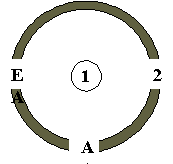
Figure 5. Openings of the reflectometer sphere.
The openings E and A for the entrance and exit of the radiation, respectively, and an opening 1 for the positioning of a sample surface, are arranged as a right-angled trihedral; another sample opening 2 is situated opposite to the entrance opening E.
With constant incident radiation, the value X measured by a detector behind the exit opening is proportional to the reflectance r of the section of the sphere's interior, which is directly irradiated (opening 2) and to the sphere's efficiency h as
X = . (1)
The sphere's efficiency is determined by the ratio of the area
FA of the exit opening A to the entire
inside surface G of the sphere and - because of multiple
reflection inside the sphere - by the sum of the geometric sequence
of the mean reflectance 

The summation starts at 0, if there is no baffle inside the sphere as in the case chosen here.
In the variant of the Taylor method applied here, the reflectance rP of an unknown sample P is measured in two steps:
- In the first step, the reflectance rK of the material K of the sphere's inside wall is determined, whereby opening 2 consists of material K. At opening 1, the sphere wall K is alternately replaced by a black light trap S with the reflectance r = 0: wall replacement step - variation of h, without changing r in (1). From the quotient of the two measured values and the geometric parameters of the sphere, the reflectance rK can be calculated taking into account suitable corrections, in particular, concerning the influence of openings E and A.
- In the second step, the known sphere wall sample K and an unknown sample P are mutually exchanged at the both openings, 1 and 2: exchange step - variation of r, without changing h in (1). From the quotient of the two measured values and the reflectance rK, the reflectance rP can then be calculated.
In principle, it would also be possible to substitute P for K at opening 1 only (wall replacement step). However, it can be shown by calculation that the measurement uncertainty then is considerably higher than that obtained in the exchange step.
The measurement device
The main part of the measurement device is the reflectometer sphere. For measurements in the UV region, a material is required for the interior of the sphere whose reflectance is high in the UV range, l > 200 nm, and which is free of fluorescence. Such a material is Optical Grade Spectralon from Labsphere [3]. However, this material has a certain translucency: Only with a thickness > 5 mm, a reflectance that is independent of the thickness of the material is reached.
This translucency is problematic for the shaping of openings 1 and 2, since sharp-edged openings are necessary, for sample positioning. This is in conflict with the requirement that for the first step (wall replacement) constant reflectance is demanded of the whole inside wall of the sphere, i.e. the wall thickness must be > 5 mm also at the openings. For the first step of the measurement, the problem can be solved by a special shaping of the sphere wall sample and of the black light trap: The sample is a cylinder suitable for introduction into the opening; the trap is supplemented by a thin black hollow cylinder also suitable for introduction. For the second step of the measurement (exchange step), attempts to determine the influence of the wall thickness experimentally and to correct it have been in vain. This is why a second reflectometer sphere with sharp-edged openings is needed, because constant interior reflectance is not required for this step. The device is supplemented by a second reflectometer sphere and its structure then is that shown in Figure 6. The reflectometer spheres have an internal diameter of 203 mm, that of the openings one of 40 mm. The monochromator has a grating with 325,5 grooves/mm and a blaze wavelength of 290 nm; spectral bandwidths from 0 mm to 12 mm can be set. A photomultiplier tube of type 6256 S (Q) (EMI Electronics) is used as a detector. The photocurrents £ 800 nA - dependent on wavelength and sample - are measured using a Keithley picoamperemeter.
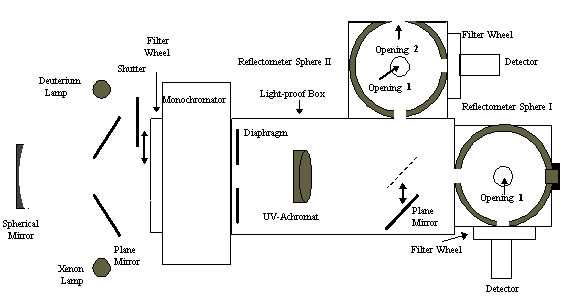
Figure 6. UV reflectance measurement device.
Investigations and results
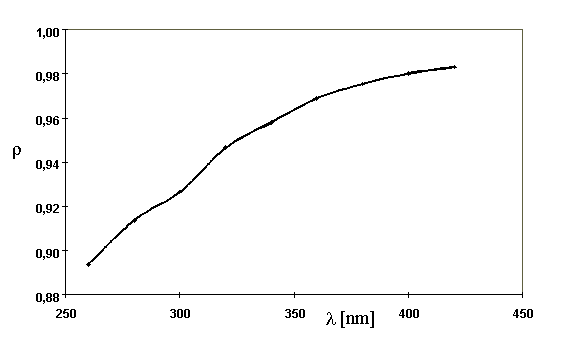
Figure 7. Reflectance of the sphere wall material "Spectralon."
The results of the first measurement step carried out for l ³ 260 nm on the sphere wall made of Spectralon are shown in Figure 7. For the range l < 260 nm, first an increase of the reflectance towards shorter wavelengths is found. This does not appear realistic and the causes must be clarified, e.g. by repeated filtering of the radiation by means of interference filters arranged in front of the detector.
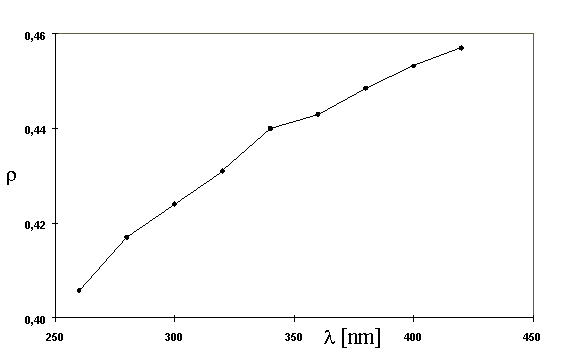
Figure 8. Reflectance of an aluminium sample.
The limited short-term stability of the measurement system equipped with a xenon lamp (standard deviation between 0,8 % and 1,5 % for 50 measurement values) makes several repetitions of the measurement series necessary. The uncertainty (twice the standard deviation) of the mean value of 12 measurement series is between 0,5 % and 1 %.
Figure 8 shows the results of the second measurement step carried out on a sand-blasted aluminium sample.
Further investigations, especially for the wavelength range 200 nm < l £ 260 nm, and comparison measurements are under way.
References
[1] A. H. Taylor, "Measurement of Diffuse Reflection Factors," J. Opt. Soc. Am. 4, 9 (1920).
[2] H. König, "Absolutmessung des Reflexionsgrades von weißen Proben bei senkrechter und diffuser Beleuchtung," Feingerätetechnik 20, 216 (1971).
[3] Diffuse Reflectance Coatings and Materials, Labsphere Catalogue (1996).
Determination of erythema
effective solar radiation with a spore monolayer film optimised
for the detection of UVB and UVA - results of a field campaign
2. Nat. Inst. Radiol. Sci. (NIRS), Chiba, Japan
3. University of Munich, Inst. for Meteorology, Germany
The available physical and biological broadband film radiometers designed to determine erythema effective radiation do not show any response or over / underestimate the biologically effective radiation to a high extent in the UVA spectral region. The data presented in this paper demonstrate that the biological system used in this study is the first one to make measurements of the erythema effective radiation in the sun in the UVA and UVB spectral regions possible. These measurements were done with a spore-film filter system as well as with spectroradiometers.
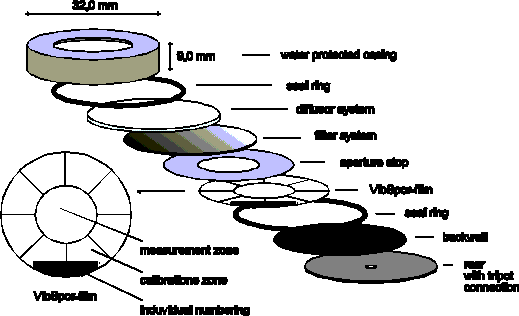
Figure 9. Casing of the VioSpor system.
The mechanical construction of a VioSpor UV detector biochip (spore monolayer film) is depicted in Figure 9.
The VioSpor data (erythemal doses) were in close correlation with the model calculations as can be seen in Figure 10.
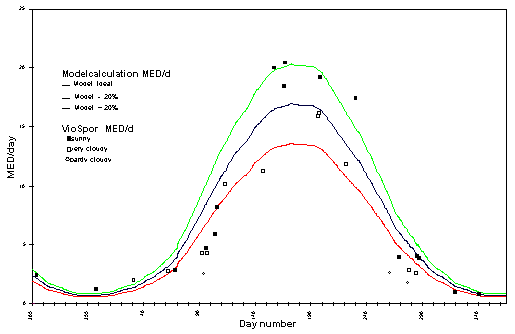
Figure 10. System intercomparison with solar radiation.
In order to validate the biochips, they were irradiated with defined doses with a monochromator. For this purpose, wavelengths within the UVB as well as in the UVA were used. The measurement results are presented in Table 6.
Additionally, the biochip data were compared with the erythemally weighted spectroradiometer data. These results are presented in Table 7.
As a conclusion, the presented data illustrate that the biotechnological
VioSpor UV film dosimeter gives reliable results (erythema weighted
doses) in measurements of field exposures. The system was validated
in various blind tests using monochromatic and solar radiation,
as well as NIST traceable reference detectors and spectroradiometers.
The diffusers used inside the entrance optics of each film dosimeter
yield reliable results, even at low solar elevation angles and
cloudy conditions. The responsivity curve of the films allows
measurements of the sun, as well as of UVA-dominated artificial
UV irradiation sources. Table 7
A fast multichannel UV-B spectroradiometer
for field measurements
for field measurements
2. iSiTEC, Bremerhaven, Germany
We have developed an instrument that works on a 32-channel detector (MCP-PMT) and offers a very fast detection (min. 1 sec) of the hole UV-B range. The photon counting mode of the PMT allows measurements of very low light levels with low noise. Because there are no moving optical parts, the instrument has a high wavelength accuracy and a good long-term stability. The housing is compact, temperature-stabilised and weatherproof. The system is controlled by a comfortable Windows software.
The non-scanning spectroradiometer operates on a Bentham DM150 double monochromator with a multichannel detector system. The detector is based on a low resistance microchannel plate with 32 independent channels running in photon counting mode. The double monochromator operates with a broad centre slit to detect the whole UV-B range simultaneously. This avoids turning the gratings during the measurement. To handle the stray-light problem in the detector chamber due to the enhanced centre slit, we apparently reduce the dynamic of the entrance signal. The instrument measures the whole spectrum between 280 nm and 320 nm every second. In the normal running mode, the spectra are integrated over five minutes and saved as an ASCII file on a PC. Because of the fixed gratings, the spectrometer offers a better wavelength stability than scanning systems. In combination with long-term stable electronics, only one calibration for an observing period of several months is necessary, so the maintenance work is very low. A field-tested, weatherproof and temperature-stabilised housing makes the instrument applicable also under heavy conditions.
For measurements under fast changing clouds, the system has the important advantage to measure the whole UV-B spectrum very fast (1 sec) and at all wavelengths simultaneously. This is particularly important in comparison of the spectra to model calculations of the radiation transfer including inhomogeneous cloud processes.
A modified version of the spectroradiometer is also suitable to measure UV-B under water down to 100 m.
On the stability of an irradiance
calibration lamp
At present, the use of tungsten-halogen quartz lamps is probably the most popular method to transfer an irradiance calibration scale from a laboratory to another. The physical stability of the lamp itself is one of the key questions on the success of the transfer. It is surprising, however, that no criteria for the objective assessment of the lamp stability exist. The creation of such criteria could clearly be one of the tasks of the Thematic Network for Ultraviolet Measurements.
Scientists can often be heard debating on the advantages and disadvantages of high and low wattage lamps in the transfer of an irradiance calibration trace. The high wattage lamps are claimed to be more subject to abrupt and unpredictable changes - reversible or irreversible - in their characteristics. On the other hand, the low wattage lamps must be brought closer to the input optics of the spectroradiometer, and consequently the point-source assumption may become invalid.
In this short study, a few such occasions were studied in more detail, where a high wattage, constant current lamp showed a change in the lamp voltage. The voltage drop occurred repeatedly, i.e. at every burn of the lamp. In one case, such a lamp developed into an uncontrollable direction with respect to both current and voltage (Figure 11).
At the time of the voltage drop, a simultaneous change in the broadband UV-A and UVB irradiance could be seen, too. Its magnitude - in this case 0,5 % in UV-A and 0,6 % in UV-B for a voltage change of 0,3 % - would suggest one to ignore the whole problem.
Spectrally the lamp output changed very little, too. Two identical lamps calibrated at a National Standards Laboratory continued producing an identical spectral calibration well within 1 %, although one of them (D04, Figure 11) showed a sudden and repeatable voltage instability of 0,4 % during its warm-up. In another case, an unstable lamp (S917, Figure 11) was inspected by the laboratory that originally supplied it, and it was found to agree within 0,3 % with the original calibration.
The above, very limited experience, would suggest that the lamp voltage instability of about 0,3 % - 0,4 % is not necessarily critical for maintenance of an irradiance scale, but may indicate a limitation to the expected life time of the lamp. On the other hand, no recommendations can be found on where the limit between a serious and non-serious instability should be placed.
Clearly, more experience on this phenomenon - affecting the daily life of numerous people in the UV community - will be needed. Generally accepted recommendations would in some cases reduce fruitless debate between the purchaser and the supplier of the lamp, would guarantee the rights of both parties, and would also help in estimating the uncertainty of measured data.
Figure
11. Left: the DXW-type 1000 W quartz-halogen lamp no.
S-885 showed variability in the voltage on June 26 and on July
30, and finally became uncontrollable on November 11. Right: the
lamps D04 and S917 of the same type behave similarly, while S918
stabilizes quickly and remains such, though at a lower voltage
(right scale).
Large-size high-sensitive thermopile as a radiometric
standard
2. Physikalisch-Technische Bundesanstalt (PTB), Braunschweig, Germany
Introduction
On the basis of an optical radiometer patented in 1979 [1], the thin-film concept [2-4] for an electrically calibrated absolute radiometer was revised by the methods of modern microsystems technology including thermal simulation. The first stage of developments is finished [5-6]. The new receiver shows promising parameters (see Table 8).
[mV/(W/cm²)] | [s] | |
| Gillham [7] | ||
| Bischoff [8] | ||
| Maslov [9] | ||
| Hengstberger [10] | ||
| Boivin [11] | ||
| Ono [12] | ||
| Müller, Ratz [3] | ||
| TS-76 (N2 filled) | ||
| TS-76 (Xe filled) | ||
Now, this large-size high-sensitive thermopile sensor [15] is already used as a radiometric standard by the PTB and the National Metrological Institutes of six other countries, as well as by the BIPM. It is also used to equip commercial measuring instruments [16].
Construction of the New radiometric receiver
The sensor chip is a 12,5 mm 12,5 mm frame-shaped Si substrate (made of a 4" (100)-Si wafer by anisotropic etching) with a centrally located 8 mm 8 mm free-standing membrane. The membrane is of SiO2/Si3N4, 800 nm thick, and stress-compensated. The sensitive area is 7 mm in diameter, the most useful region being 5 mm in diameter. The housing consists of a glass tube (Xe-filled for minimal thermal conductance) or metallic package (N2 filled) with a wedge-shaped (1,5°) quartz or CaF2window.
Succession of the functional layers
The chip has NiCr/Al bond contact pads, which are located on the Si frame. The thermopile consists of 76 elements, which have their active junctions on the membrane and reference junctions on the Si frame. The thermopiles are built up using a multi-layer technology, photolithographic patterning, and wet-chemical etching (Table 9).
| Notes | ||
| Bi0.87Sb0.13 | ||
| Photoresist AZ 1514 H | for isolation | |
| Sb | ||
| Photoresist | ||
| Thin-film heater | meandered, 750 Bi0.87Sb0.13, 7 mm | |
| Photoresist | ||
| Thermal equalising layer | Ag, 7 mm | |
| Absorbing layer | Ag (or Au) metallic black (deposited @ 80 Pa N2), 7 mm |
Sensor features
The most important features of TS-76 are listed in Table 10.
| Notes | ||
| Responsivity | > 10 V/W | |
| Time constant | ~ 1 s | |
| ResistanceThermopile | 4 … 5 k | |
| ResistanceHeater | 6 … 7 k | |
| NEP | 0,9 nW | calculated (RTh = 5 k, T = 300 K, f = 1 Hz) |
| < 5 nW | measured (incl. noise of preamp) | |
| Linearity1 | < 0,5 % @ P < 1 mW | electrically measured |
| < 1 % @ P 3 mW | ||
| Time constant | 460 ms | N2 filled |
| 1 s | Xe filled | |
| Power responsivity2 | 10 - 14 V/W | Xe filled |
| 4 - 5 V/W | N2 filled | |
| Irradiance responsivity2 | 4.600 - 5.400 mV/(W/cm²) | Xe filled |
| 1.550 - 1.925 mV/(W/cm²) | N2 filled |
1 Our input power of optical measurement was always
in the region < 1 µW … 1 mW.
2 Optical and electrical measurements.
Spectral sensitivity
In principle, thermal sensors (like the thermopiles) show a wavelength-independent sensitivity. Small differences are caused by a wavelength-dependent absorber or (in case of vacuum or Xe filled housing) by the transmittance of the used window. We have used silver (or gold) metallic black as absorber [13, 14].
Long-term stability
For the "vacuum" (i.e. Xe backfilled) thermopile, a decreasing of the responsivity by 3 - 4 % was noticed during the first months after the manufacturing of these receivers, as a result of a deterioration of the vacuum. In contrast to this, N2 filled thermopiles (measured @ air pressure of 10-3 Pa) show constant responsivity. However, independent of these observations, the TS-76 thermopiles are suitable as transfer standards, because it is possible to check the calibration of the receiver by the built-in electrical heater at any time.
Spatial homogeneity of responsivity
Because the homogeneity of the radiation of lasers or monochromators cannot be ensured, and because the illumination conditions of the receiver in different measuring systems are not exactly identical, the local homogeneity of the responsivity is an important parameter of a radiometric receiver. Typical values (in arbitrary units) of the remaining inhomogeneity of the local responsivity of a Xe filled TS-76 receiver are 0,9975 (centre) and 1,0263 (at a distance of 2,5 mm from the centre).
Conclusions
The novel thermoelectric radiometric receiver meets in all essential parameters the demands which are required from a transfer standard. They possess a very good homogeneity, comparable with photo-diodes, high enough responsivity, and a sufficiently large receiver area at the same time.
Acknowledgement - This work has been supported by the microsystems innovation support program of the German Federal Ministry of Education, Science, Research and Technology, Collaborative Project "THERMIS," Grant No. 13 MV 0085.
References and literature
[1] J. E. Müller and P. Ratz, GDR Patent WP 147 872 (1979).
[2] J. E. Müller and P. Ratz, Proc. 9th Symp. IMEKO TC2 on Photon-Detectors, Visegrad, 317-324 (1980).
[3] J. E. Müller and P. Ratz, Feingerätetechnik 31, 175-177 (1982).
[4] W. Budde, in Optical Radiation Measurements, Vol. 4, Edited by F. Grum and C. J. Bartleson (New York, Academic Press, 1983) pp. 134-142.
[5] E. Kessler, J. E. Müller, F. Völklein, M. Pawlak, K. Möstl, and F. Brandt, Proc. SPIE Vol. 1712, 14th Symp. on Photonic Measurements, 132-141 (1992).
[6] E. Kessler, H.-C. Holstenberg, M. Pawlak, K. Möstl, and J. Metzdorf, in Innovationen in der Mikrosystemtechnik, Vol. 26, Edited by VDI/VDE, Teltow, 107-128 (1995).
[7] E. J. Gillham, Proc. Roy. Soc. A269, 249-276 (1962).
[8] K. Bischoff, Optik 28, 183-189 (1968).
[9] V. A. Maslov, Sbornik Dokl. 5. Vsesojusn. Sovešc. Teplovye priemniki izluceniya, G.O.I. Leningrad, 36-42 (1973).
[10] F. Hengstberger, NPRL, Counsil of Scient. and Ind. Res., Res. Rep. 331, Pretoria (1977).
[11] L. P. Boivin and T. C. Smith, Appl. Opt. 19, 3067-3075 (1978).
[12] A. Ono, Metrologia 15, 127-133 (1979) and Jpn. J. Appl. Phys. 18, 1995-2002 (1979).
[13] J. Vogel, Proc. 9th Symp. IMEKO TC2 on Photon-Detectors, Visegrad, 325-335 (1980).
[14] H. Neff, S. Henkel, J. K. Sass, E. Steinbeiss, P. Ratz, J. E. Müller, and W. Michalke, J. Appl. Phys. 80, 1058-1062 (1996).
[15] Thin-Film Thermopile TS-76, IPHT/PTB Data Sheet (1998).
[16] Optical Standard Power Meter OPM-1, Wandel & Goltermann, P.O.Box 1262, D-72795 Eningen u.A. (1998).
Announcing the Third Workshop in Teddington,
September 8 - 10, 1999
September 8 - 10, 1999
Introduction
The 3rd Workshop of the Thematic Network for UV Measurements will be arranged at the National Physical Laboratory (NPL), Teddington, United Kingdom, on September 8 - 10, 1999. All participants are requested to register by sending the registration form (page 39) to NPL by June 11.
As in Braunschweig, the programme starts with parallel sessions of the working groups. If you belong to more than one working group, you may only attend one. Please indicate in the registration form, which session you would like to attend!
Preliminary Programme
The time schedule of the following programme is rather preliminary but the contents are fixed. The final programme will be published with the next UVNEWS in July.
Wednesday, September 8, 1999
| Afternoon | Excursions to the laboratories of NPL |
Thursday, September 9, 1999
| 8:00 | 9:00 | Registration, preparations of the poster exhibition | |
| 9:00 | 9:30 | Welcome words by NPL and the co-ordinator, outline of the programme | |
| 9:30 | 12:00 | Parallel working group (WG) meetings | |
| 12:00 | 13:00 | Lunch | |
| 13:00 | 15:00 | WG meetings continue | |
| 15:00 | 18:00 | Joint gathering where WG's give their reports | |
| 19:00 | > | Conference dinner |
Friday, September 10, 1998
| 9:00 | 12:00 | Scientific presentations on UV measurement techniques (for topics and speakers, see next page) | |
| 12:00 | 13:00 | Lunch | |
| 13:00 | 14:00 | Discussion about practical items of the Network | |
| 14:00 | 15:00 | Poster session | |
| 15:00 | 16:00 | Final meeting of the WG's |
Presentations
On Friday, there will be oral presentations that have been selected by the Network steering group, consisting of the co-ordinator and the working group leaders. Abstracts on the contents of the presentations will be published in the next UVNEWS.
- Uncertainty evaluation (John Hurll, UKAS, Feltham, UK)
- Measurement of actinic radiation (Prof. Dr.-Ing. Wolfgang Heering, Lichttechnisches Institut, Universität Karlsruhe, Germany)
- High power UV-lasers and UV-measurement techniques for excimer lasers (157 nm - 351 nm) - state of the art and future developments (Dr. Manfred Rahe, Lambda Physik GmbH, Göttingen, Germany, and Dr. Klaus Mann, Laser-Laboratorium Göttingen, Germany)
- UV measurements in artificial weathering of polymeric materials (Bo Carlsson, SP, Borås, Sweden)
- Integral UV-Meters - Physical principles - States of the art - Problems of applications (Anton Gugg-Helminger, Gigahertz Optic, Germany)
In addition, there will be a combined presentation of equipment and posters. This presentation will be set in the beginning of the workshop and may be viewed during breaks. If you wish to present equipment, please contact Bill Hartree at NPL so that we can account for your space requirements. If you wish to present a poster, please send the title and a short abstract to Petri Kärhä at the Helsinki University of Technology by June 11. These abstracts will be published in the July issue of UVNEWS. Contact information for Bill Hartree may be found on page 38 and for Petri Kärhä on page 2.
Venue
NPL is located in Teddington, in south-western part of London. Detailed information on how to reach NPL, including detailed maps, may be found in the Internet pages of NPL: "http://www.npl.co.uk/npl/about/index.html". The closest airport is the Heathrow airport. It takes typically 40-60 minutes by bus No. 285 to reach NPL (get off the bus at Teddington Hospital: The driver will tell you which stop if you ask). The bus fare is about £1. A taxi from the airport costs more than £25.
Accommodation
Accommodation has been arranged at St. Mary's College Strawberry Hill, which is located 1,5 km from NPL. You can reach NPL from the College by the No. 33 bus, which runs every 10-15 minutes. Rooms at the college are available with en suite bathroom and toilet, price £35, or with shared bathroom and with about four other people at a price of £28. Since there will probably not be enough en suite rooms for all people attending you should book early. Phone no. +44 181 240 4114, fax no.+44 181 240 4255.
In addition, some rooms have been booked at hotels somewhat further from NPL:
- The Quinns Hotel, Richmond (about 8 km from NPL, by train): rooms without en suite facilities: £40 per night. +44 181 940 5444, fax no.+44 181 940 1828
- Shandon House Hotel, Richmond (about 8 km from NPL, by train): rooms without en suite facilities: £30 per night. +44 181 940 5444, fax no.+44 181 940 9900
- The Liongate Hotel, Hampton Court (2 km from Hampton Court: no public transport to NPL available): all en suite, £80 per night. +44 181 977 8121 +44 181 943 4029
- The Carlton Mitre Hotel (3 km from Hampton Court: no public transport to NPL available): all en suite, £105 per night. +44 181 979 9988, fax no.+44 181 979 9777
If you wish to stay at any of these hotels, you should contact them directly, quoting the reference "UV Thematic Network."
A map showing the location of the College and hotels will be sent to those attending on receipt of their registration forms.
Workshop Fee
The participants of the UV Network project (about 60 persons) are invited to attend the workshop without paying a participation fee. Accompanying persons and guests have to pay a workshop fee of £50. This fee is paid with the registration at NPL. The participation fee covers the costs of lunch on Thursday and Friday and the evening dinner on Thursday.
Local Organizer
The local arrangements of this workshop will be organised by the National Physical Laboratory:
| NPL Management Ltd National Physical Laboratory Dr. Bill Hartree Queens Road, Teddington Middlesex, TW11 OLW United Kingdom | Telephone: +44 - 181 - 943 6416 Telefax: +44 - 181 - 943 6935 E-mail: wsh@npl.co.uk |
Registration
Form
National Physical Laboratory
Teddington, UK
September 8 - 10, 1999
Please mail, fax or E-mail the corresponding information by June 11, 1999 to
NPL Management LTD
National Physical Laboratory
Dr. Bill Hartree
Queens Road, Teddington
Middlesex, TW11 OLW
United Kingdom
Telefax: +44 - 181 - 943 6935
E-mail: wsh@npl.co.uk
Participant of the UV Network
Accompanying Person (Participation Fee: £50)
Guest (Participation Fee: £50)
I Wish to attend parallel session of Working Group 1 2 3 4 (circle)
Family Name: ___________________________________ Title: ____________
First Name(s): ____________________________________________________
Company: ____________________________________________________
Address: ____________________________________________________
_________________________________________________________________
Country: ____________________________________________________
Telephone: ____________________________________________________
Telefax: ____________________________________________________
E-mail: ____________________________________________________
Training Course for Ultraviolet Measurements,
September 6 - 8, 1999
September 6 - 8, 1999
The Thematic Network for Ultraviolet Measurements arranges a training course on UV measurement techniques at NPL (Teddington, UK) on September 6 - 7, 1999. In addition, there will be a possibility to visit the laboratories of NPL on Wednesday, September 8. The training course is aimed for industrial technicians and for scientists new to the field. The training course is combined with the 3rd workshop of the Network, where the participants are most welcome.
The presentations will be kept at quite basic level, and they cover both practical and theoretical issues on various topics. The preliminary contents of the presentations are as follows:
- Introduction
- Sources of ultraviolet radiation
- High power measurements
- Materials
- Spectroradiometric measurements
- Detectors
- Measurements for health
- Broadband measurements
- Solar UV measurements
- Calibration techniques, traceability, quality assurance
- Uncertainty evaluation
- New developments in the field of UV measurements
A more detailed announcement, including a detailed schedule and the names of the teachers, will be sent later. For the venue and accommodation details, same details apply as for the 3rd workshop (see page 37). The participation fee for the course will be approximately 550 Euros.
The same training course will be arranged in central Europe (probably in Germany or Austria) in year 2000.
For further information contact:
| NPL Management Ltd National Physical Laboratory Dr. Bill Hartree Queens Road, Teddington Middlesex, TW11 OLW United Kingdom | Telephone: +44 - 181 - 943 6416 Telefax: +44 - 181 - 943 6935 E-mail: wsh@npl.co.uk |
Working Groups
The Network has four working groups, each working on a selected key issue in UV measurements. The working groups are operating mainly by exchanging E-mail. If you wish to join a working group or be informed about its activity, please contact the corresponding working group leader. You may also use the service card at the end of this UVNEWS.Working group 1: Guidance for UV power meter classification for particular applications
Gigahertz-Optik
Director Anton Gugg-Helminger
Fischerstrasse 4
D-82178 Puchheim, Germany
+49-89-89015920
Fax: +49-89-89015950
a.gugg-helminger@go-puchheim.de
Working group 2: Improvement of measurement and calibration methods for spectrally resolved UV measurements
Physikalisch-Technische Bundesanstalt
Department 4.1 Light and Radiation
Prof. Dr. Jürgen Metzdorf
Bundesallee 100
D-38116 Braunschweig, Germany
+49-531-5924100
Fax: +49-531-5924105
Juergen.Metzdorf@ptb.de
Working group 3: Improvement of measurement and calibration methods for spectrally weighted UV measurements
NPL Management LTD
National Physical Laboratory
Dr. Nigel Fox
Queens Road, Teddington
Middlesex, TW11 OLW, United Kingdom
+44-181-9436825
Fax: +44-181-9436935
nigel.fox@npl.co.uk
Working group 4: UV Measurements related to health and safety
University of Dundee
The Photobiology Unit
Dr. Harry Moseley
Ninewells Hospital & Medical School
DDI 9S4, United Kingdom
+44-1382-632240 / +44-1382-633894
Fax: +44-1382-646047
H.Moseley@dundee.ac.ukThe next pages contain the first annual
reports of the working groups. More information can be found at
the Internet pages of the working groups
If you would like to add some material to the web pages of your working group, please consult the corresponding working group leader.
Annual Reports of the Working Groups
Working Group 1: Guidance
for UV Power Meter Classification for Particular Applications
This Group will concentrate on making an international proposal for characterisation of UV-meters.
Aim
To produce a proposal which could be accepted, or parts of it, by other committees which are working on similar regulations.
State of the art
There is no general accepted regulation for characterising UV-meters in the world.
To achieve its aim, WG1 has been working on getting information from the other working groups in the world, which are also working on drafts for this topic.
We are in contact with:
- Berufsgenossenschaft Fachausschuss Elektrotechnik "Incoherent optical radiation,"
- CIE TC 2-47 " Characterisation and calibration methods of UV radiometers,"
- CIE TC 6-45 "Workplace safety,"
- DIN FNL 7.5 "Radiometer for measurement of actinic radiation quantities,"
- MOHR "International Symposium and Workshop on Measurement of Optical Radiation Hazards," and
- WMO-SAG "Instruments to measure solar ultraviolet radiation."
We want to find a consensus view on the above ideas and to make our own proposal for industrial UV-radiometry.
Actions taken
All members were informed about the aims and the regulations to get easy and effective communications. The first proposals on how to classify UV-meters were made. The members gave feedback via E-mail and phone. The group contacted other working groups in the world via E-mail and phone mentioned above and got also invitations to visit some of the groups. We were able to be active at the group "Berufsgenossenschaft Fachausschuss Elektrotechnik" with the theme "Inherent optical radiation." After making the 1st draft of the document, all members got the information. With the feedback of this, the 1st revised draft was made.
Progress
Revised 1st Draft of the document "Characterising the performance of integral measuring UV-meters" was released on 27.10.98.
Plans for the future work
We plan to take part in the "DIN FNL 7.5" group with the theme "Radiometer for measurement of actinic radiation quantities" and continue with the "Berufsgenossenschaft Fachausschuss Elektrotechnik." Also, we will be looking at the papers given from the other groups mentioned above. We will rework the paper again with the new information from the other groups.
In the final paper, the following items should be included:
- definitions of the possible uncertainties of the detector head and read out meter,
- classifications of the UV-meters depending on the uncertainties,
- calibration methods, and
- measurement methods for the user for getting less additional uncertainties.
With this proposal, either the manufacturer of UV-meters or the user of them should be able to classify their UV-meters. This means that the manufacturer will get information on how to characterise the meters with detector-heads and how to calibrate them. The user will get information on how to do good measurements with less addition of uncertainties.
During our work, we have found that it will be necessary to look also at the spectral UV-measurements, because these measurements are the basis for the integral reachable uncertainties. Also, we have found that for measurements weighted with action spectra, the UV-range has to be extended.
Reported by Anton Gugg-Helminger, February 12, 1999.
Working Group 2: Improvement
of Measurement and Calibration Methods for Spectrally Resolved
UV Measurements
Objectives
The objectives of WG 2 are:
- To determine the user requirements for spectrally resolved calibrations of standards and characterisations of instruments and components in the field of non-coherent UV radiometry and spectrophotometry;
- To stimulate and promote the improvement and development of measurement techniques and exchange of experiences based on the respective needs and problems as well as on the state-of-the-art methods, devices and instruments identified by WG 2 before;
- To prepare and publish a report with examples of the expression of the uncertainty of measurement in UV radiometric calibrations based on the documents EAL-R2 and EAL-R2-S1 and in compliance with the recommendation of the ISO Guide to the Expression of Uncertainty in Measurement. The goal is to demonstrate the method of evaluating the uncertainty of measurement in spectroradiometry, to support the reduction of the too large uncertainties in UV radiometry and to facilitate the evaluation of realistic reported uncertainties.
Background
Based on the discussion during the first meeting and based on the feedback on a first questionnaire, WG2 will cover the following areas in the field of non-coherent UV radiometry and spectrophotometry:
Calibration of detectors, spectroradiometers, sources (lamps), reflection standards and filters; characterisation/testing of detectors, sources, optical instruments, components, materials and surfaces.
UV dosimetry (irradiance more than 10 mW cm-2) will be treated by WG3, and although UV laser radiometry is of increasing importance (e. g., in photolithography), this field will be excluded because only one WG2 member seems to be involved.
In the classification of measurement and calibration methods including QA/QC requirements, the following categories are distinguished: absolute calibrations requiring traceability to SI units and national standards as well as recognition of the equivalence of the standards for the respective units and scales (e. g., calibration of a lamp as a UV standard of spectral irradiance); characterisation and testing based on relative measurements (e. g., measurements of the angular response of a diffuser to determine cosine error).
Actions taken
WG 2 with 33 members was formed during the first workshop in Espoo (March 1998), meanwhile with more than 60 members including guests after the first WG 2 meeting.
A first questionnaire has been sent to the members of WG 2 in order to determine the state of the art and needs in the field of spectrally resolved UV measurements and, moreover, to find out the work areas covered by the members of WG 2. About 25% of the participants replied.
The first WG 2 meeting during the second workshop in Braunschweig (November 1998) focused on scope and delimitation of WG 2 work, the discussion of the feedback on the first questionnaire and the identification of measurement problems. Special attention was paid to the evaluation of uncertainties including QA/QC requirements. Uncertainty evaluation in the case of spectrally resolved UV measurements including interpolation of data is a pressing problem which will require much more attention and work in the future.
Three speakers were invited for presentations during the second workshop to exemplarily cover different areas of the field of WG 2. Thus, the following talks were given:
- Rabus (PTB, Berlin): Evaluation of the Radiometric Performance of UV Photodetectors;
- Jordan (Osram GmbH, München): UV Measurements at an Industrial Calibration and Measurement Laboratory;
- Webb (UMIST, Manchester): Uncertainty Estimate for the Spectral Measurement of Solar UV Radiation.
Progress
First of all, the scope of WG 2 work has been defined and our objectives established. Some of the needs and problems already identified are as follows, where several members reported on activities to overcome the respective difficulties: discrepancies between standards of UV spectral irradiance from different National Metrology Institutes (NMIs); stability of UV radiometric standards (lamps and detectors); calibration of UV spectroradiometers for field measurements including transfer from horizontal to vertical optical axis; total (4) UV spectral radiant power measurements for an overall lamp characterisation; measurement of the transmittance of UV filters. Up to now, there is more feedback from institutes involved in the monitoring of UV solar radiation than from industry and calibration laboratories.
Uncertainty evaluation has been started with a draft for the calibration of a standard of spectral irradiance describing measurement problem, mathematical model and sources of uncertainty of measurement. Furthermore, the uncertainty evaluation of interpolated spectral data is an important subject under discussion, where the first proposal was mainly an introduction to this problem.
In the field of UV monitoring, WG2 refers to the QC/QA activities of the WMO [A. R. Webb et al., Guidelines for Site Quality Control of UV Monitoring, WMO/GAW Report No. 126, 1998] gathering information on additional and specific uncertainty sources of UV spectroradiometers for field measurements.
Plans for the future work
The next WG 2 meeting will take place during the third workshop in Teddington (September 1999).
Future work including the preparation of the next meeting is based on the feedback on more questionnaires and on drafts for the preparation of the report on uncertainty evaluation. According to the first objective, the second questionnaire has already been sent to all members and guests in December 1998. In order to motivate as many members as possible to reply, this questionnaire is reduced to provide information only about the problems and requirements in the case of spectrally resolved UV measurements. Based on these results, questionnaires and e-mail messages will be used to succeed in our second objective.
Examples of uncertainty evaluation according to the third objective will be prepared separately. Drafts will be sent by e-mail asking for corrections, comments as well additional and alternative points or sections:
- Uncertainty evaluation will be started with a draft for the calibration of a standard lamp of spectral irradiance.
- As one area of the EU project "Improving the accuracy of UV radiation measurements" is the establishment and comparison of UV spectral responsivity scales based on cryogenic radiometers achieving a reduced uncertainty, an important joint goal is also the respective uncertainty evaluation of detector calibration.
- Finally, the uncertainty evaluation of interpolated spectral data is indispensable to spectrally resolved measurements, where the proposal during the first meeting will be the basis for a separate draft.
Reported by Jürgen Metzdorf, February 17, 1999.
Working Group 3: Improvement
of Measurement and Calibration Methods for Spectrally Weighted
UV Measurements
Objectives
The objectives of this Working Group are:
- to define the user requirements for calibration,
- to determine the current best practise, and
- to develop/recommend best techniques for the calibration of spectrally weighted UV measurements as a function of accuracy/application.
This will culminate in the production of a document which will help those making measurements or suppliers of equipment to identify sources of uncertainty relevant to their application and an appropriate method to assess its level
Background
The aim of this working group is to draw together problems and requirements from a range of technical areas and hopefully bring together solutions/ best-measurement practise from one technical area into another. It is clear that at the start of this exercise, interaction between groups is relatively poor. It is also true that some technical disciplines are more advanced than others (notably solar UV monitoring), but also that the demands of some are not as critical.
The main aim at the start of the project is to get together a pool of information as to what is known and what is perceived to be known with the aim of linking it together in a document which then provides readers with links to the current state-of-the-art in terms of measurement/characterisation for their particular measurement application. However, an important goal in this is to ensure that the selected solution is only at a level required by the application and does make the application economically non-viable.
Actions taken
The group has so far carried out its activities through a process of questionnaires and discussion at a meeting of the second workshop. This process has sought to identify:
- the types of measurement carried out which require a spectrally weighted function,
- the uncertainty requirements for the application,
- uncertainties achieved both specified by manufacturers and believed by users, and
- possible sources of uncertainty.
Progress
A significant baseline of knowledge has been procured as to the underpinning requirements, although there are still some gaps in the knowledge base, particularly for dosimetry applications, although efforts are being made to identify inputs to this. It is expected that during the next year, a draft document will be produced which will identify all potential sources of error and review potential calibration/characterisation methods. This document will also seek to develop a structure to allow the reader to identify their type of application and from that assess the error sources likely to contribute, and their relative size so that a decision can be made as to which type of instrument should be used for which application and which sources of error need to be investigated in detail.
Plans for the future work
Ultimately, it is intended that the document in its final form will be published and be available widely probably linked or incorporated in the document being developed through WG1. Similarly, the document is likely to involve inputs from WG4. During the next period a first draft is intended to be produced.
Reported by Nigel Fox, March 2, 1999.
Working Group 4: UV Measurements
Related to Health and Safety
Aim
The aim is to provide practical advice on suitable measurement techniques in health and safety aspects of ultra-violet radiation.
Background
There are known hazards caused by exposure to UV radiation. Also, its use in medicine is potentially beneficial. Recently, there have been widespread concerns over the safety of sunbeds and also uncertainty on appropriate measurement techniques.
Actions taken
The working group was formulated at the first meeting of the network in Espoo, Finland 2-3 March 1998 and subsequently met in Braunschweig Germany 9-11 November 1998. In addition, considerable communication has taken place by E-mail. The group decided to concentrate initially on sunbeds and to produce an agreed methodology appropriate for measuring UV from an artificial tanning unit.
Progress
It has been established that the relevant standard throughout the EC is EN 60335-2-27 (March 1997) although other complementary or normative standards or guidelines also exist. At present, there are areas where there is a difference of interpretation. These include site of measurement, use of mean or maximum values. Equivalency of replacement lamps is another difficulty. WG4 is identifying these areas. It was noted that Finland, France, Norway and Sweden had regulations covering UV emissions from sunbeds.
It has become apparent that there is a need for a common approach to how measurements are carried out.
Health risks were identified as follows: skin cancer, reduced immunlogical status, skin ageing, erythema, keratitis, cataract. Benefits were: cosmetic, psychological, vitaminD. The opinion of the group was that the risks greatly outweigh the benefits. There is a need for public information.
Training needs for operators were considered. This should include advice on replacement lamps and filters.
Plans for the future work
The working group will seek to produce a consensus view on interpretation of the European standard for sunbed testing.
The working group will seek to produce a recommendation on how measurements should be carried out on artificial tanning units. This will include establishing a database of existing published studies and guidelines, describing necessary measurement tasks, and specifying performance requirements for suitable measuring devices.
The need for public information will be considered further.
Training needs for operators will be considered further.
Reported by Harry Moseley, February 12, 1999.
2nd International Workshop
on Detector-Based UV Radiometry,
Madrid, Spain, 28 October 1999
Madrid, Spain, 28 October 1999
The Second International Workshop on Detector-Based Radiometry will take place on October 28, 1999 as a Satellite Workshop to the NEWRAD'99 conference hosted by the CSIC in Madrid.
Scope of the Workshop
Like its predecessor, the 2nd International Workshop on Detector-Based Radiometry is intended to provide an opportunity for the mutual exchange of information on status, aims and current activities in the field of detector-based UV radiometry.
Part of the workshop will be devoted to reports on the status of the Agreed EUROMET Project "Evaluation of the radiometric performance of UV photodetectors" that was established as an outcome of the first workshop.
Contributions on other activities in the field of UV radiometry are particularly welcome and researchers involved in such projects are encouraged to present their results at the workshop.
Preliminary Workshop Program
- New developments in UV detectors and facilities for their investigation
- Agreed EUROMET Project "Evaluation of the radiometric performance of UV photodetectors"
- Reports on other activities in detector-based UV radiometry
- Issues related to the forthcoming intercomparisons in the UV
Workshop Organisation
The workshop will have only oral presentations. Presented papers can be included in the NEWRAD'99 proceedings on the basis of the same criteria as for papers of the NEWRAD conference. For abstract and paper submission deadlines please refer to the Second Circular of the NEWRAD'99 conference.
For further information please contact:
| Physikalisch-Technische Bundesanstalt (PTB) Dr. Hans Rabus Abbestraße 2-12 D-10587 Berlin Germany | Phone: +49-30-82004-231 Fax: +49-30-82004-238 E-mail: Hans.Rabus@ptb.de |
Please mail or fax to:
| Physikalisch-Technische Bundesanstalt Dr. Hans Rabus Abbestraße 2-12 D-10587 Berlin Germany | E-mail: Hans.Rabus@ptb.de Fax: + 49 - 30 - 82 00 42 38 |
Family Name Title(s)
First Name(s)
Affiliation
Address
Country
Phone: Fax:
E-mail:
Title of paper:
To register for the workshop, please complete this form and send
it (or a copy of your registration for the NEWRAD'99 conference)
by mail or fax to the address given above. You may also provide
the requested information by e-mail.
News-Flash
A New UV Detector Calibration Service
The UV Laboratory at Guys' & St Thomas' Hospital, London, announces a new UV meter calibration service aimed at clinical phototherapy centres, research groups and other users of UV meters. Measurements of absolute spectral irradiance responsivity at power levels between 0,1 and 2,0 mW/cm2 are provided at specified wavelengths (10 nm bandwidth) in the range from 250 nm to 400 nm.
This is presently the only service in UK offering calibrations that are formally traceable to the national standards held by NPL, with a best measurement capability (k = 2) of 6 %. This level of measurement uncertainty is at least half that available from current spectroradiometry based UV meter calibration systems. It is, therefore, expected to prove particularly valuable in medical, research and environmental monitoring of UV exposure, where comparable calibration uncertainties of 20 % are currently quoted.
The given certificate provides discrete wavelength responsivities as well as spectral correction factors applicable when the meter is used with broadband tubes (e.g. Philips or Waldmann PUVA, TL01, UV6, UV21 types). The laboratory operates a quality system and is currently at an advanced stage in seeking UK government accreditation via the United Kingdom Accreditation Service (UKAS). Calibration of one detector head currently costs £254 + VAT + postage & packing.
Further information:
| Guys' & ST Thomas' Hospital Medical Physics Directorate UV Laboratory Andrew J. Coleman London, SE1 7EH United Kingdom | Phone: +44 - 171 - 922 8072 Fax: +44 - 171 - 922 8279 E-mail: a.coleman@umds.ac.uk |
Brochure for European Optical Radiation Calibration
Services
NPL has completed the first draft of the Brochure for European Optical Radiation Calibration Services. This brochure describes calibration services offered in the field of optical radiation measurement by National and Accredited Laboratories throughout the EU. It aims to enable the reader, in industry and elsewhere, to easily obtain information on the calibration services which are available for optical radiation throughout Europe. The brochure has been developed within project SMT4-CT96-6511, funded under the Standards, Measurement and Testing (SM&T) research and development programme, Directorate General XII, Commission of the European Communities. Included in the funding is a provision to update the information contained in the brochure within two years.
National Measurement Institutes who have contributed to the brochure are:
- Bureau National de Métrologie (BNM-INM, BNM-LCIE, BNM-LNE), France,
- Centro de Ciencias e Tecnologias Ópticas (CETO), Portugal,
- Danish Institute of Fundamental Metrology (DFM), Denmark,
- Helsinki University of Technology - Metrology Research Institute(HUT), Finland,
- Instituto de Física Aplicada (IFA), Spain,
- Instituto Elettrotecnico Nazionale Galileo Ferraris (IEN), Italy,
- National Physical Laboratory (NPL), United Kingdom,
- Nederlands Meetinstituut - Van Swinden Laboratorium BV (NMi-VSL), Netherlands,
- Physikalisch-Technische Bundesanstalt (PTB), Germany,
- Swedish National Testing and Research Institute (SP), Sweden,
- Swiss Federal Office of Metrology (OFMET), Switzerland, and
- Physikalisch-Meteorologisches Observatorium, Davos (PMOD/WRC), Switzerland.
The documentation has been published in 8 different languages, forming three publications. The first publication is primarily in English with supplementary information in French, German, Finnish, Italian and Swedish. The other two publications are written in Spanish and Portuguese, respectively. The calibration services are divided into five broad subject areas: Detector and Laser Characterisation, Photometry, Spectroradiometry, Spectrophotometry and Colorimetry, and Fibre Optics. The contact details of laboratories mentioned in the Brochure are given. Also, intercomparisons and EU Collaborative Projects carried out in the field of optical radiation within the last ten years can be found.
A copy of the brochure can be found in English on the WWW/Internet, address http://www.NPL.co.uk/. Paper copies are available upon request from the mentioned National Standards Laboratories or from NPL.
Further information:
| National Physical Laboratory Fiona Jones Teddington Middlesex, TW11 0LW United Kingdom | Phone: +44 - 181 - 943 6743 Fax: +44 - 181 - 943 6283 E-mail: fiona.jones@npl.co.uk |
Internet Pages of the UV Thematic Network
The WWW-pages of the Network have finally been opened in March, 1999. The pages may be found in the address: http://metrology.hut.fi/uvnet/. The following items have been included in the pages so far:
- General information about the Network and the Working Groups,
- Contact information for the participants and WG members, including postal and E-mail addresses, and links to WWW-pages,
- Mailing lists for the Working Groups and participants,
- Reports and Newsletters published so far,
- Minutes of meetings and workshops,
- News and forthcoming events like workshops.
Improvement of the pages will continue in 1999. We welcome all comments and suggestions about the contents of the pages.
Further information:
| Helsinki University of Technology Metrology Research Institute Petri Kärhä P.O.Box 3000 FIN-02015 HUT Finland | Phone: +358 - 9 - 451 2222 Fax: +358 - 9 - 451 2289 E-mail: petri.karha@hut.fi |
A new UV measurement system
A new UV-instrument will be available from iSiTEC and Alfred-Wegener-Institut during 1999. The instrument consists of a revised UV-B device (double monochromator and microchannel plate detector) with a new UV-A unit based on a single monochromator with a diode array detector. The system is controlled by a new user-friendly windows software which offers a comfortable automatic operation and the recording of the hole UV-range (280-400 nm) within 1 sec. The instrument is equipped with a weatherproof and temperature-stabilised housing (size: 600 600 600mm) and allows an operation with less maintenance.
Further information:
| iSiTEC Ingenieur-Büro Hanken&Hoops GbR Thomas Hanken | Phone: +49-471-14088-0 Fax: +49-471-14088-3 E-mail: thanken@isitec.de or thanken@awi-bremerhaven.de |
| Alfred-Wegener-Institut Dr. Helmut Tüg | Phone: +49-471-4831-190 Fax.: +49-471-4831-149 E-mail: htueg@awi-bremerhaven.de |
Levy Hill Laboratories makes name and address change
Levy Hill Laboratories Ltd is fast becoming a world leader in scintillation materials and phosphor coatings technologies for a wide variety of industrial, medical and scientific imaging and detection applications. Due to this expansion, the business is moving to new larger premises, 5 times the current size, in Harlow, England. The new site includes dedicated clean room facilities and high performance analytical instrumentation for quality control, and research and development. In addition to new facilities, the personnel has been augmented making almost half the company qualified to Doctorate level.
Chairman Dr. W. Henderson is enthusiastic about the future for the company saying: "With such a major change, we thought it entirely appropriate to change our name at the same time. We particularly value our existing customers but for our fast expanding customer base, we feel our name should more accurately reflect our function."
Levy Hill Laboratories Ltd will become Applied Scintillation Technologies from 1st January, 1999 and operate from Roydonbury Industrial Estate, Harlow.
In addition to its Radiometer/Photometer product and Calibration Service, Applied Scintillation Technologies serves many other markets including coated diode arrays, security imaging, dental and medical imaging, biotechnology and scientific instruments.
Applied Scintillation Technologies will continue to serve the UV measurement community and will aim to extend its range of products and services into the new millennium.
For further information go to http://www.appscintech.com/ or contact the managing director, Iain Gray. The technical contact for the UV Thematic continues to be Dr. Glenn C. Tyrrell (R&D Manager).
Further information:
| Applied Scintillation Technologies Ltd Dr. Glenn C. Tyrrell 8 Roydonbury Industrial Estate, Harlow Essex, CM19 5BZ United Kingdom | Phone: +44 - 1279 - 641 234 Fax: +44 - 1279 - 413 679 E-mail: g.tyrrell@appscintech.com or ast@appscintech.com |
New Swedish regulatory code for sunbeds available
in English
The Swedish Radiation Protection Institute (SSI) has issued new regulations on sunbeds (SSI FS 1998:2), effective from January 1, 1999.
Swedish regulations on sunbeds require tanning equipment for cosmetic use among the public:
- to have limited levels of UVA- and UVB-radiation,
- to meet the criteria of the international IEC and European EN-standard 60-335-2-27 for UV-type 3 appliances, and
- to be accordingly labelled and equipped with appropriate sunbed lamps.
Information on risks associated with sunbed use is mandatory and to be posted at sunbeds in tanning salons etc. Young people under 18 are advised not to use sunbeds. The equipment manufacturer's user information and exposure schedule must also be available.
A translation into English (SSI information i99:01) of the new regulations is available directly from SSI or can be obtained at SSI's webpages http://www.ssi.se/.
Further information:
| Swedish Radiation Protection Institute Mr. Ulf Wester SE-17116 Stockholm Sweden | Phone: +46 - 8 - 729 7171 Fax: +46-8-311714 E-mail: ulf.wester@ssi.se |
First announcement of a symposium: UV measuring techniques -
novel developments
Place and time: PTB Braunschweig, Germany, October 7 and 8
The DafP - German Academy of Photobiology and Phototechnology will arrange a symposium on UV measuring techniques on October 7 - 8, 1999 together with the PTB in Braunschweig. Seven lectures and a poster exhibition will be presented. Additionally, an excursion to the PTB laboratories in Braunschweig is intended.
Topics of presentations
- Novel stable UV detectors,
- Actinic broadband UV radiometers,
- New multichannel UV spectroradiometers,
- Calibrating UV radiometers - state of the art,
- Adequate equipment and arrangement of an UV measuring laboratory,
- Measurements of erythemally effective radiation on sunbeds - uncertainties,
- Monitoring UVC radiation in systems of disinfection.
For further information, please contact the office of the DafP:
| TU Ilmenau - FG Lichttechnik Dr. J. Fisch P.O.Box 100565 DE-98684 Ilmenau Germany | Phone: +49 - 3677 - 202 934 Fax: +49 - 3677 - 842 463 |
New products and publications from BioSense
BioSense announces the completion of two new products. The film dosimeter "VioSpor blue line III+" for long time UV-dosimetry completes the VioSpor UV-dosimetry program of BioSense. Four different dosimeter types (0 - III+) are now available. The type III+ is usable up to 500 MED (125.000 J/m2) per measurement period. Precise long-term UV-dosimetry for several weeks or months is no problem anymore. All the other advantages of the VioSpor system are included. These include e.g. high accuracy, easy handling, robustness, independence of power sources, design, price etc.
Two VioSpor red line types for DNA-weighted measurements have been completed as well. With "VioSpor red line DNA" it is possible to measure the DNA damaging capacity of UV-B and UV-C irradiation (J/m2). With "VioSpor red line 245" you have a suitable, easy-to-use system to verify the germicidal efficiency of your UV-C lamp (e.g. in your sterile working bench). Values are given in terms of germicidal (indicator spore) efficiency.
VioSpor detectors have been tested in various campaigns, which has resulted in three new publications. The erythema-effective solar radiation in Japan and Germany were measured with VioSpor, and the results were compared with common spectroradiometric measurements (Brewer) in a field campaign [1]. The results demonstrate the high accuracy of VioSpor. The standard deviation between the two measurement methods was only about 10 %.
The application of VioSpor as an in-vivo-adapted measurement method for the determination of the UPF (UV protection factor), at different steps of the preparation of cotton, was explained [2]. The results demonstrate a variation of the UPF dependency of the preparation steps of the cotton in a range of 2 up to 100. Critical aspects of common standards (e.g. Australian standard) will be discussed.
The German test magazine OEKOTEST tested 30 solaria in Berlin [3]. The consulting of the studios, and the applied UV-doses (measured by VioSpor) during the advised exposure period, were tested. The result was that in most cases, the consulting was insufficient causing an erythema for the person tested (skin type II, untanned).
References
[1] Y. Furusawa et al, Appl. Microbiol. Biotechnol. 50, 597 - 603 (1998).
[2] Knittel et al (in press).
[3] OEKOTEST, Heft 12, 4 - 5 (Dez. 1998).
Further information:
| BioSense Labor für Biologische Sensorik Quintern & Holtschmidt GbR Lothar Quintern Moernerstraße 45 D-53332 Bornheim Germany | Phone: +49 - 2222 - 934090 Fax: +49 - 2222 - 934091 E-mail: mail@biosense.de Internet: http://www.biosense.de/ |
P-9710-1 Optometer - A new multimeter for UV-applications
from Gigahertz-Optik
| Gigahertz-Optik announces a new hand-held UV-multimeter which can be used in various applications (Figure 12). This compact multimeter may be purchased with various interchangeable detector-heads, which makes it suitable for practically any UV-measurement application. Examples of the various action spectra that may be obtained can be seen in Figure 13.
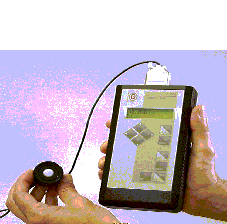
|
Key features:
|
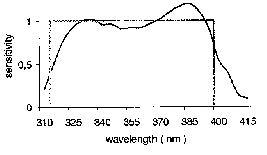 |
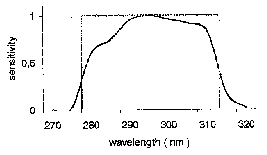 |
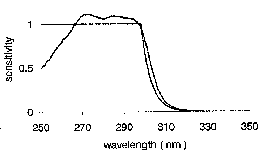 |
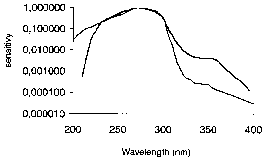 |
Figure 13. Examples of action spectra that can be replicated:
UV-A (top left), UV-B (top right), UV Erythema (bottom left),
ACGIH (bottom right). Both nominal and actual functions of the
spectral sensitivity are shown.
Further information:
| Gigahertz-Optik GmbH Fischerstraße 4 D-82178 Puchheim Germany | Phone: + 49 - 89 - 89 01 59 0 Fax: + 49 - 89 - 89 01 59 50 E-mail: contact@go-puchheim.de Internet: http://www.go-puchheim.de/ |  |
Two-Beam Alignment Lasers
OMTec has developed a new, compact two-beam laser for alignment purposes. With this laser, a complete optical beam path from the source to the detector can be adjusted at a stretch. The beam of a very high quality diffraction limited diode laser of 635 nm wavelength is splitted up into two beams of opposite direction on a common optical axis using a patented laser-mirror arrangement. With a precision autocollimation procedure, both of the two beams are adjusted exactly on the same axis. The alignment error between the two beams is less than 0,5 mrad. For adjustments, the two-beam laser can be fixed at any position of an optical beam path.
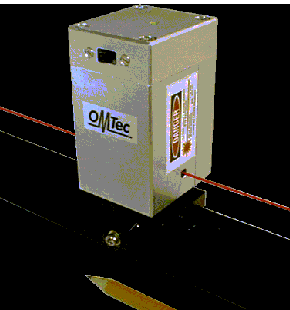
Figure 14. OMTec two-beam alignment laser.
The laser can be driven by an external power supply or by internal
batteries or accumulators. In spite of the integrated batteries
(accus) for more than 25 h of cordless operation, the small size
of this alignment laser (40 x 45 x 75 mm; H x W x L) ensures an
universal usability as it is small enough to be used even within
bad accessible arrangements. A datasheet of the two-beam alignment
laser is available at http://www.omtec.de/
Further information:
| OMTec Gesellschaft für optische Meßsysteme Volker Bentlage Potsdamer Straße 8 D-14513 Teltow Germany | Phone: +49 - 3328 - 303 619 Fax: +49 - 3328 - 303 620 E-mail: mail@omtec.de |
Service Card
Receiver: Helsinki University of Technology
Petri Kärhä
Telefax: +358 - 9 - 451 2222
Remove me from your mailing lists and do not send me material related to the Thematic Network for Ultraviolet Measurements anymore.
Add me to your mailing lists and send me material related to the Thematic Network for Ultraviolet Measurements in the future.
I would be interested to join the Working group nr. 1 2 3 4 (circle)
Update my contact information
__________________________________________________________________
_______________________________________________________________________
_______________________________________________________________________
_______________________________________________________________________
Sender:
Company: ______________________________________________________________
Departement / Lab.: ______________________________________________________
Name: _________________________________________________________________
Title (circle): Prof. Dr. Mr. Mrs. Ms. Other: ______________________________
Address: ________________________________________________________________
________________________________________________________________________
Country: ________________________________________________________________
Telephone: ______________________________________________________________
Telefax: _________________________________________________________________
E-mail: __________________________________________________________________


